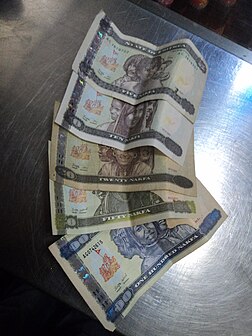
Back نقفة إريترية Arabic ناكفا ARZ Nakfa AST Eritreya nakfası Azerbaijani Nakfa BAT-SMG Эрытрэйская накфа Byelorussian Эрытрэйская накфа BE-X-OLD ইরিত্রিয়ান নাকফা BPY Nakfa Breton Nakfa Catalan
 Nakfa banknotes | |
| ISO 4217 | |
| Code | ERN (numeric: 232) |
| Subunit | 0.01 |
| Unit | |
| Symbol | Nfk (Latin script) ናቕፋ (Ge'ez script) ناكفا (Arabic script) |
| Denominations | |
| Subunit | |
| 1⁄100 | Cent |
| Banknotes | 1, 5, 10, 20, 50, 100 nakfa |
| Coins | 1, 5, 10, 25, 50 cents, 1 nakfa |
| Demographics | |
| Date of introduction | 15 November 1997 |
| User(s) | |
| Issuance | |
| Central bank | Bank of Eritrea |
| Valuation | |
| Inflation | 9% |
| Source | April 2017[1] |
| Pegged with | U.S. dollar = 15 nakfa |
The nakfa (ISO 4217 code: ERN; Tigrinya: ናቕፋ naḳfa, or Arabic: ناكفا or نقفة nākfā) is the currency of Eritrea and was introduced on 15 November 1997 to replace the Ethiopian birr at par. The currency takes its name from the Eritrean town of Nakfa, site of the first major victory of the Eritrean War of Independence. The nakfa is divided into 100 cents.
The nakfa is pegged to the US dollar at a fixed rate of US$1 = ERN 15. At earlier times,[when?] it was officially pegged at US$1 = ERN 13.50. The currency is not fully convertible, so black market rates available on the streets typically offered a rate of 15 nakfas per dollar.[2][needs update]
Between 18 November and 31 December 2015, the Bank of Eritrea began replacement of all nakfa banknotes. The banknote replacement initiative was designed to combat counterfeiting, the informal economy but primarily Sudanese human traffickers who had accepted payments in nakfa banknotes in exchange for transporting would-be migrants primarily to Europe. A consequence of this was substantial amounts of the country's currency existed in vast hoards outside of Eritrea.
The plan to replace the country's currency was top secret and designed to prevent human traffickers bringing their funds back in time to exchange for the new banknotes.[3] On 1 January 2016 the old nakfa banknotes ceased being recognized as legal tender, rendering external stockpiles of currency worthless.[4]
The current series of banknotes is the artwork of an Afro-American banknote designer, Clarence Holbert,[5] and printed by German currency printer Giesecke & Devrient.[6]
- ^ Inflation rate, average consumer prices, IMF, April 2017, retrieved 9 October 2017
- ^ A Broke Nation (PDF), Université Cheikh Anta Diop de Dakar, 2004, archived from the original (PDF) on 22 October 2016, retrieved 22 October 2016
- ^ Eritrea won't shorten national service despite migration fears, Sallina News, 2016, retrieved 22 October 2016
- ^ Meet the New Eritrea Nakfa Bank Notes, Tesfa News, 2015, retrieved 22 October 2016
- ^ Designing Eritrea's Money was 'Dream Come True', Tesfa News, 2015, retrieved 22 October 2016
- ^ Currency and exchange facilities, Eritrea Be, 2015, retrieved 22 October 2016